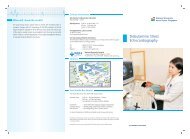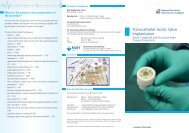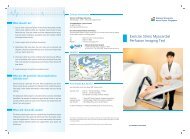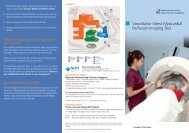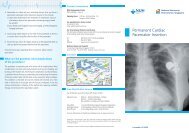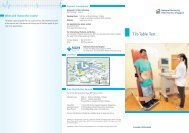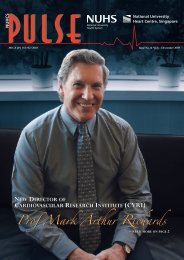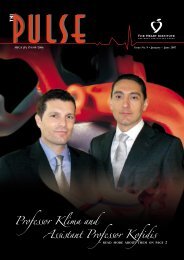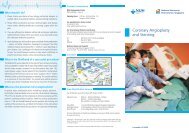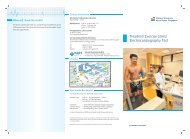January - June - nuhcs
January - June - nuhcs
January - June - nuhcs
You also want an ePaper? Increase the reach of your titles
YUMPU automatically turns print PDFs into web optimized ePapers that Google loves.
MICA (P) 110/12/2008 Issue No. 13 • <strong>January</strong> – <strong>June</strong> 2009<br />
New Chief of Cardiac Department<br />
A/Prof Yeo Tiong Cheng<br />
– read more on page 3
in this issue<br />
02 A/Prof Tan’s awards in China<br />
03 PULSE Interview: New Head of<br />
Cardiac Department, NUHCS<br />
A/Prof Yeo Tiong Cheng<br />
04 Palliative Care in Heart Failure<br />
05 Singapore Cardiac Society ASM<br />
Young Investigator Award (YIA)<br />
Being an International Medical<br />
Student in Cardiac Department,<br />
NUHCS<br />
06 The New President of ASCVTS:<br />
Congratulations to Professor<br />
Lee Chuen Neng<br />
proof of Concept – A Novel<br />
Heart Valve Implantation<br />
Mechanism: Pioneering Heart<br />
Valve Surgery<br />
A/Prof Tan’s<br />
awards in China<br />
– Visiting<br />
Professorship and<br />
CIT Award<br />
08 NUHCS – 2P event<br />
09 America College of Cardiology<br />
ASM – Orlando experience<br />
10 HMDP Trip to Melbourne<br />
– Cardiac Rehabilitation<br />
11 4th Introductory Course in<br />
Interventional Cardiology<br />
12 HMDP Fellowship<br />
13 My UK Experience<br />
14 5th Asian Interventional<br />
Cardiovascular Therapeutics<br />
Shanghai, China<br />
15 Cardiac & Cardiothoracic-<br />
Vascular Nursing Programme<br />
16 Happenings<br />
18 Abstracts & Publications<br />
20 Directory & New Doctors on<br />
Board<br />
Editor<br />
A/Prof Poh Kian Keong<br />
Advisor<br />
A/Prof Tan Huay Cheem<br />
Contents are not to be reproduced<br />
without the permission of NUHCS<br />
Assoc Professor Tan Huay<br />
Cheem, Director of NUHCS,<br />
was conferred the China<br />
Intervention Therapeutics<br />
(CIT) Contribution Award<br />
2009 at the recently held<br />
CIT meeting in Beijing. CIT<br />
is the largest endovascular<br />
intervention meeting held annually in China with the participation<br />
of more than 3000 international and local faculties and attendees.<br />
The award is in recognition of Associate Professor Tan’s ‘outstanding<br />
contribution and continuing dedication to the development of<br />
interventional cardiology in China’, as was described. Assoc Prof<br />
Tan has been working in China for the last 10 years during which<br />
he has trained many Chinese interventional cardiologists in many<br />
provinces, participated in live demonstration of percutaneous<br />
coronary intervention in various physician exchange programmes,<br />
delivered multiple lectures with his fluent command of Mandarin,<br />
and collaborated in multicentre clinical trials.<br />
Assoc Prof Tan was also awarded a Visiting Professorship<br />
from Henan University affiliated HuaiHe Hospital in KaiFeng,<br />
Henan, China, in April 2009. This is the third Chinese Visiting<br />
Professorship title for Assoc Prof Tan who has previously also been<br />
conferred a Visiting Professor with Beijing University and Shanghai<br />
JiaoTong University.<br />
THI PULSE |
PULSE Interview<br />
– new Head of<br />
Cardiac Department,<br />
NUHCS<br />
A/Prof Yeo Tiong Cheng<br />
How do you feel about this new appointment ?<br />
I am deeply honored to be given this opportunity to head this<br />
great department. At the same time, I am apprehensive as the<br />
responsibility that comes with this appointment is immense.<br />
My predecessors are “big names” in the cardiology world and this<br />
appointment is like a “ pair of oversized shoes”. As you know, my<br />
feet are pretty small.<br />
What is your vision for the department in the next five<br />
years?<br />
Since its formation in 1989, the department has grown both in<br />
physical size and stature. The next 5 years will be very challenging<br />
times especially with the recent formation of the National University<br />
Health System (NUHS) and the National University Heart Centre,<br />
Singapore (NUHCS). I would like the department to be recognized<br />
for its excellent clinical service, comprehensive and structured<br />
teaching programmes for both undergraduate and postgraduate<br />
doctors and paraclinical staff, and equally excellent research output.<br />
It will be the institution of choice for patients with complex cardiac<br />
problems, a place where young doctors and nurses will choose to<br />
be trained in, and a department where research culture is pervasive.<br />
Lastly, I hope that it will be a cohesive department where the staff<br />
are like members of a big family.<br />
What are some changes that you intend to bring to the<br />
department?<br />
The department has expanded at a great pace in terms of the range<br />
of services provided. I think it is time to consolidate our strengths,<br />
reevaluate our next goals and then move on. The most important<br />
asset to a department is its staff and I am privileged to have a group<br />
of bright, conscientious and hardworking people to work with. Staff<br />
development (both in terms of personal career development and<br />
training) and staff welfare is of utmost importance. In order to<br />
meet the challenges ahead, we will continue to increase our talent<br />
pool at all levels. In terms of clinical services, the department<br />
will continue to grow the 4 core clinical programmes of NUHCS.<br />
As the department grows in size and range of services increases, coordination<br />
of services become very important and I would like the<br />
department to be able to provide integrated and well co-ordinated<br />
service to our patients and partners. To be a true academic medical<br />
centre, our clinical services must be supported by a strong research<br />
base of basic scientists and clinical researchers. To this end, I hope to<br />
see advancement in our basic science and translational research.<br />
How different do you think your leadership style will<br />
differ from your predecessors?<br />
I have always believed in a consultative leadership style and to lead<br />
by example. Any input from my colleagues is important and I will<br />
listen to them. I also do not subscribe to micromanagement. You<br />
have to trust the people you work with.<br />
THI PULSE |
palliative care<br />
Dr Angeline Seah<br />
in heart failure<br />
An increase in the number of patients with risk factors<br />
for atherosclerosis, the ageing population, and improvements in<br />
technology to save patients from myocardial infarction has lead to<br />
a steady increase in patients who develop heart failure in the latter<br />
half of their disease trajectory.<br />
With improving medical knowledge, many patients with<br />
heart failure can be treated and even stabilised, but a proportion of<br />
patients will progress to end stage heart failure in spite of optimal<br />
treatment. Comprehensive holistic patient care requires that the<br />
care continuum extends to this final chapter, acknowledging that<br />
death and dying is an integral part of life.<br />
... caring for and counselling<br />
these patients and their families<br />
has been tremendously fulfilling<br />
for this team in the Advance Care<br />
Program, with reciprocal feelings<br />
from families.<br />
Patients with end stage heart failure suffer from a significant<br />
symptom burden of breathlessness, confusion, fatigue, pain and<br />
depression, with a need to contend with prognostic uncertainty<br />
including sudden cardiac death. Families and loved ones are often<br />
anxious and in need of information and support. A palliative<br />
approach combined with active care where possible has much to<br />
contribute to alleviate their suffering, and support the cardiologists’<br />
honest sensitive communication to enable patients and their loved<br />
ones to plan realistically for their future.<br />
Since 2008, a dedicated team of doctors, nurses and<br />
counsellors set up by NHG has been supporting patients with<br />
end stage heart failure, both in medical aspects such as managing<br />
symptoms, preventing exacerbations, and avoiding other<br />
complications, as well as in psychosocial aspects. Many symptoms<br />
can be controlled or reduced with judicious pharmacological<br />
treatment or non-pharmacological interventions. A counsellor<br />
The team in the Advance Cardiac Care Programme<br />
conducts a life review with the patient to help him in this last phase<br />
of psychological development, attain a sense of life completion, and<br />
help the family and patient make sense of his life and its meaning<br />
to them. Patients are then often ready to talk about their end of life<br />
hopes and plans, which guides medical therapy decisions and frees<br />
the family from the burden of having to make decisions for their<br />
loved ones at a moment when they may be distraught and grieving.<br />
Grief and yearning after death is often made more bearable by<br />
the knowledge that everything had been done for their loved one,<br />
that his wishes had been fulfilled, by open communication and the<br />
saying of ‘goodbyes’.<br />
End-of-life issues though still a ‘taboo’ subject in our local<br />
culture, with many medical personnel shying of approaching the<br />
topic until the inevitable comes, caring for and counselling these<br />
patients and their families has been tremendously fulfilling for this<br />
team in the Advance Care Program, with reciprocal feelings from<br />
families. To date, much appreciation has been received in the form<br />
of donations, cards and emails.<br />
As the palliative care team journeys and learns with the<br />
cardiology team in holistic approach and comprehensive care for<br />
these patients, it is hoped that much will be gleaned to inform<br />
future practice improving the care for patients suffering from<br />
heart failure.<br />
THI PULSE |
Singapore Cardiac Society ASM<br />
Young Investigator Award (Y IA)<br />
Dr Ye Lei<br />
Heart failure is an enormous medical and social burden.<br />
It is estimated that 7.6 million died from heart attack every year<br />
world-wide, resulting in 30 to 40% of mortality from heart<br />
failure within 1 year of diagnosis. In Singapore, more than 18% of<br />
total death was due to ischemic heart disease (MOH). Recently,<br />
therapeutic angiogenesis for neovascularization of ischemic<br />
myocardium is being researched. As myocardial ischemia is a<br />
recurring and often progressive condition, we designed a hypoxia<br />
regulated vascular endothelial growth factor-165 gene (HRE-VEGF)<br />
delivery system that is probably better and more appropriate<br />
strategy compared to conventional delivery systems. This system<br />
can respond to hypoxic signals to switch on trans-angiogenic gene<br />
and amplify their expression to induce neovascularization and<br />
ameliorate ischemic condition. The study is funded by BMRC and<br />
Dr Eugene Sim is the PI.<br />
We used nanoparticle to transfect skeletal myoblast (SKM)<br />
with HRE-VEGF gene for therapeutic angiomyogenesis. It was<br />
found that HRE-VEGF transfected SKM not only restored the<br />
contractility of the ischemically weakened heart but also controlled<br />
the expression of VEGF in ischemic myocardium. The study was<br />
awarded Young Investigator Award (First prize, Basic research) at<br />
The 21st Annual Meeting of Singapore Cardiac Society (March<br />
21st - 22nd 2009) and Best Paper Award at Chinese University of<br />
Hong Kong-Mayo Clinic-Asia Cardiovascular Summit, Hong Kong<br />
(Feb 18th -19th 2009).<br />
being an international medical student<br />
in Cardiac Department, NUHCS<br />
Laura Beck<br />
In my first weeks as a German medical student doing<br />
Cardiology in Singapore, I nearly got lost in a variety of<br />
English accents and medical abbreviations. Besides the local medical<br />
students, there were students from all over the world including<br />
Australia, Taiwan, India, Indonesia, Canada and Sweden as well as<br />
more German students arriving a few weeks after me.<br />
Doing the ward rounds in the general wards or CCU or<br />
walking around the hospital for kilometers with the overflow team<br />
gave us an impression of the diversity of Singaporean patients and<br />
particularities in the treatment of their conditions, including the<br />
management of language, cultural and social problems. Further<br />
insights were obtained from different outpatient clinics such as<br />
those managing new cases, follow-up appointments, patients<br />
with arrhythmias or congenital heart diseases, pacemakers and<br />
much more. We were able to observe the performance of various<br />
procedures like echocardiography, treadmill or nuclear scan, the<br />
diagnostic and therapeutical procedures in the cath lab including<br />
Laura Beck (Rightmost)<br />
angiograms, ballooning, stenting and electrophysiology studies as<br />
well as the management of emergency cases. These were all part<br />
of the working day of a cardiologist. Our theoretical knowledge<br />
was improved by daily CMEs and a lot of questions and answers.<br />
I managed to do some research with Assoc Professor Poh Kian<br />
Keong, my mentor and attended the Singapore Cardiac Society’s<br />
Annual Scientific Meeting which A/Prof Poh is the organizing<br />
chairman. Time passed by very quickly and I flew back to Germany<br />
with a lot of new impressions and reminders of the friendly<br />
team and atmosphere in the whole department. Thanks a lot for<br />
everything!<br />
THI PULSE |
the new President of ASCVTS<br />
Congratulations!<br />
Professor Lee Chuen Neng<br />
Founded in 1993, the Asian Society for Cardiovascular<br />
& Thoracic Surgery (ASCVTS) aims to promote the study<br />
of the art, science and practice of cardiovascular and thoracic<br />
surgery. It also seeks to facilitate the exchange of ideas in the field<br />
of cardiovascular and thoracic surgery through scientific meetings<br />
and by personal contact between cardiovascular and thoracic<br />
specialists.<br />
ASCVTS is the only Asian representative on the CTS Net<br />
(together with the American Association of Thoracic Surgery,<br />
the Society of Thoracic Surgeons and the European Association of<br />
Cardio-Thoracic Surgery). Their official journal – Asian Thoracic<br />
& Cardiothoracic Annals (of whom Professor Lee is a founding<br />
member of the Editorial board) is also the one representing Asia<br />
(together with the Journal of Thoracic and Cardiovascular Surgery,<br />
the Annals of Thoracic Surgery and the European Journal of Cardio-<br />
Thoracic Surgery).<br />
During the recent congress and executive council meeting<br />
held in Taiwan on 04 March 2009, Professor CN Lee was elected<br />
as President of the Asian Society for Cardiovascular & Thoracic<br />
Surgery (ASCVTS) for a term of 2 years (renewable). Prof Lee is<br />
the first non-Japanese to be elected President for the ASCVTS.<br />
Prof Lee is one of the founding executive council members<br />
of ASCVTS. He is also an active member of the ASCVTS holding<br />
the following positions:<br />
(i) President of Congress:<br />
(a) 7th Annual Congress of the ASCVS in 1999 held in<br />
Singapore<br />
(b) 16th Annual Congress of the ASCVS in 2007 held in<br />
Singapore<br />
(ii)<br />
(iii)<br />
Executive Council Member: 1993 to present<br />
Committee Member:<br />
(a) Database Committee, 1999 onwards<br />
(b) Publication Committee, 2003 onwards<br />
The annual congresses held in various Asian countries (from Tokyo<br />
to Istanbul) serve as a platform for cardiovascular specialists from<br />
different parts of the world to share their ideas and experience on<br />
various aspects of cardiovascular sciences and practices. It has since<br />
been considered the gold standard meeting for cardiac, thoracic<br />
& vascular surgeons in Asia. Membership of ASCVTS has reached<br />
1,000 and is growing rapidly across Asia’s cardiothoracic surgical<br />
groups and regions.<br />
Over the past 10 years, ASCVTS had developed an Asian<br />
database and risk models for coronary and aortic surgery and would<br />
be launching this across Asia.<br />
THI PULSE |
proof of concept –<br />
a novel heart valve implantation mechanism<br />
pioneering<br />
heart valve surgery<br />
Assist Prof Theodoros Kofidis<br />
Translational research should be patient centered and<br />
immediately applicable. It should be based upon concepts that<br />
can be taken from bedside to bench, and then back to bedside. It<br />
should be guided by impact on patient lives.<br />
At NUHS Department of CTVS we have designed a new<br />
implantation mechanism for heart valves. The National Research<br />
Foundations agreed to fund the Proof of Concept phase, towards<br />
development of the prototype.<br />
Whenever a human mitral valve is destroyed by disease,<br />
mitral valve replacement may be needed. It involves removal of the<br />
natural valve and the placement of a large number of deep stitches<br />
into the mitral annulus. Thereby, important structures, such as<br />
the conduction system or coronary vessels may be injured. The<br />
procedure usually lasts 3 hours.<br />
Our approach involves an implantable mitral ring which<br />
constitutes the housing for the valve. The valve itself can then<br />
simply be twisted into position, much like a bayonet or light bulb.<br />
The bayonet housing will be made of metal parts (carbontitanium),<br />
or it can consist of synthetic rigid or<br />
flexible materials. The implantation procedure<br />
will be significantly shorter (< 30 minutes) and<br />
less risky. In this first phase we will be implanting<br />
the prototype into pigs, and compare it to the<br />
regular prostheses in the market.<br />
Mitral valve disorders have a high incidence<br />
in South East Asia, mostly due to rheumatic<br />
disease, resulting in regurgitation or<br />
stenosis. In the advanced state<br />
the valve must be replaced. The<br />
operation requires stopping the<br />
heart for more than an hour.<br />
Lengthy and surgically traumatic<br />
operations in heart surgery<br />
means higher risk, costs and<br />
longer recovery times for the<br />
patient. These may be reduced if<br />
there is an implantation method<br />
and device available which would (i) shorten the time needed to<br />
stop the heart, (ii) require no stitches to the natural mitral valve<br />
ring and (iii) allow easy replaceability if the patient ever requires<br />
re-do surgery. Our new implantation device is expected to reduce<br />
heart arrest time to 20 minutes and total operation time to a bit<br />
more than an hour. We expect to be able to operate more than 200<br />
patients every year from Singapore, 1,000 from South-East Asia and<br />
around 10,000 worldwide.<br />
Press Coverage<br />
• Channelnews Asia, 18th Dec 2008<br />
• Radio 93.8, 18th Dec 2008<br />
• The Straits Times, 19th Dec 2008<br />
• Business Times, 19th Dec 2008<br />
• TODAY, 19th Dec 2008<br />
• Lianhe Zaobao, 19th Dec 2008<br />
Daily business: mitral valve replacement using sutures: soon… “forgotten Art”?<br />
THI PULSE |
NUHCS<br />
2P event<br />
Mr Michael Leow<br />
During the week of 18th to 22nd May 2009, a Process<br />
Preparation (2P) event was held as part of the planning<br />
process for the expansion and set-up of the National<br />
University Heart Centre, Singapore (NUHCS) at the current<br />
Dental Block, levels 1 and 3 in the Main Building, NUH. Renovation<br />
works are targeted to begin in <strong>January</strong> 2010, while the entire project<br />
is expected to be completed by May 2011.<br />
The 2P event for NUHCS aims to plan and design the new<br />
NUHCS layout around lean concepts. It was a collective effort and<br />
decision making process involving all stakeholders to derive the<br />
best layout ensuring appropriate clinic set-ups and facilities so as<br />
to derive optimal staff and patient flow.<br />
Facilitated by the NUHS Way team, this event was led by<br />
Mr Michael Leow (Head, Operations and Administration, NUHCS).<br />
With the support of Adj A/Prof Tan Huay Cheem (Director,<br />
NUHCS and Head, Cardiac Department), Clin A/Prof Yeo Tiong<br />
Cheng (Deputy Head and Senior Consultant, Cardiac Department),<br />
Adj Prof Michael Caleb (Clinical Director and Senior Consultant,<br />
Department of Cardiac, Thoracic and Vascular Surgery), and<br />
A/Prof Peter Robless (Senior Consultant, Department of Cardiac,<br />
Thoracic and Vascular Surgery), a combined team of clinicians,<br />
administrators, nurses and allied health staff were brought<br />
together. Our colleagues from Pharmacy, Rehabilitation Medicine,<br />
Infection Control, Laboratory Medicine, Environmental Services<br />
and Corporate Planning & Development also participated at<br />
appropriate junctures.<br />
The event began with an opening message by our CEO,<br />
Mr Joe Sim. He thanked the team for participating in this event<br />
which not only would serve to provide better care for our patients<br />
but would also improve our work experience in NUH. Following<br />
that, Ms Heidi Rafman (Assistant Director, NUHS Way) shared<br />
with us the key principle of ‘Lean’ - providing the best healthcare<br />
services with the least waste.<br />
Thereafter, the real work began! The team started by<br />
identifying the requirements of various rooms and facilities based<br />
on the projected volume using the Takt Time calculations. We<br />
studied process points, distance travelled and other factors affecting<br />
patients and staff. In order to compare if the existing requirements<br />
were met, patient-service takt time and resource utilizations were<br />
also computed.<br />
Some questions that we posed to ourselves included ‘How<br />
could we reduce waiting time?’ and ‘How could we improve from<br />
our existing layout to better facilitate the flow for patients in the<br />
new set-up?’ Value Stream Mapping of the current process flows<br />
helped us to identify the gaps in our existing processes from the<br />
THI PULSE |
America College<br />
of Cardiology ASM<br />
Orlando<br />
Dr Yeo Wee Tiong<br />
experience<br />
patients’ perspective. This enabled us to brainstorm improvement<br />
initiatives for future process flows of the new NUHCS.<br />
The most challenging part of the event was the designing<br />
of not 1 or 2, but 5 different layouts for the new NUHCS.<br />
There were many views, likes and preferences. As such, it was<br />
a tedious process for all of us. However, everything went well as<br />
we focused on our main goal of enhancing patient experience at<br />
the new NUHCS. Subsequently, a ‘beauty’ contest based on predetermined<br />
criteria such as patient flows, patient safety and staff<br />
motion was carried out. The various designs for each criterion<br />
were scored and the best overall layout was selected. We did not<br />
stop there. We continued to improve upon the winning layout<br />
by incorporating the best qualities from the other layouts to<br />
obtain the hybrid “best of the best” design! In addition, physical<br />
simulation of the proposed consultation room was also carried<br />
out to ensure that the space requirements were feasible.<br />
All in all, the event was an excellent opportunity for<br />
everyone to come together as a team to learn and to apply<br />
the 2P methodology which helped us in the development of a<br />
preliminary framework for the set-up of the new NUHCS.<br />
Lastly, kudos to the entire team for all their hard work<br />
during this event!<br />
The 2P event for NUHCS aims<br />
to plan and design the new<br />
NUHCS layout around lean<br />
concepts...<br />
This year’s American College of Cardiology Annual<br />
Scientific Meeting was held at the Orange County Convention<br />
Centre in Orlando, Florida. This was held in conjuction with the<br />
Innovation in Intervention (i2) Summit. The meetings were held<br />
over 4 days from 28th to 31st March 2009.<br />
I had the privilege of attending this conference to present<br />
a poster on “Long term effectiveness of drug eluting stents in the<br />
treatment of in-stent restenosis” at the i2 Summit.<br />
A/Prof Tan Huay Cheem was honoured to be the only<br />
invited faculty from Singapore to speak at one of the plenary<br />
sessions at the i2 summit. He lectured on balancing the risk between<br />
perioperative bleeds and stent thrombosis from antiplatelet therapy<br />
cessation in patients with drug eluting stents undergoing non cardiac<br />
surgery. His session was well received.<br />
The first thing that stuck me was the scale and intensity of<br />
this meeting. Being my first conference, I was impressed by the<br />
passion of the organizers and attendees for cardiology. I have never<br />
thought that breakfast symposia starting from 5:30 in the morning<br />
would attract anyone but it sure did! It truly gives new meaning to<br />
what it is like to eat, drink and live cardiology.<br />
This meeting was fruitful not only advancing my<br />
understanding for cardiology. It was a great time to catch up with<br />
friends and colleagues who are working in the United States.<br />
A/Prof Tan organised a dinner at the Fulton Crab House where<br />
we met up with Dr Carolyn Lam and Chen Lin Yee. The food<br />
and company was great! I look forward to attending next year’s<br />
conference to be held in Atlanta.<br />
THI PULSE |
HMDP Trip to Melbourne<br />
Cardiac<br />
Rehabilitation<br />
Dr Raymond Wong<br />
Melbourne, the second city of Land Down Under,<br />
welcomed us on a cool Sunday morning with promises of fun,<br />
excitement, and enlightenment. In Heart Research Center (HRC)<br />
based in the Royal Melbourne Hospital, we came to seek knowledge<br />
in abundance and friendship in sincerity. We were rewarded lavishly<br />
in both respects.<br />
The Cardiac Rehabilitation (CR) contingent of four (Shuet<br />
Ming, Suzanna, YiJun and I) had specific individual aims in mind in<br />
embarking on this group-based training trip. Collectively though,<br />
we intend to enhance our respective roles and performance within<br />
the domain of our CR program, and to perfect our coordination and<br />
cooperation in presenting a holistic lifestyle modification program<br />
for the patients’ benefit. We can then assume the role of leaders for<br />
Singapore at large in this subspecialty.<br />
The 5-Day Training Course began with an ice-breaking<br />
session by the Director of HRC, Dr Marion Worcester. She exuded<br />
grace and authority, and instilled much confidence among the<br />
participants of what the next few days might bring. To out initial<br />
surprise, a third of the participants were engaged in setting up/<br />
running of rural CR program, comprising in part of the Aboriginals<br />
subjects. Some programs had to grapple with issues relating to<br />
multi-ethnic environment where different cultures, mentalities and<br />
diets presented unique problems individually. During the next five<br />
days, starting with Dr Alan Goble who is a doyen in CR medicine,<br />
the experienced team of lecturers covered wide ranging topics in<br />
cardiovascular system, medications, exercise physiology, program<br />
set-up, organization and evaluation, heart failure rehabilitation,<br />
diabetes, psychology, nutrition, smoking cessation, and behavior<br />
modification and motivation. We found these topics to be exquisitely<br />
relevant to our day-to-day running of CR program; in the queerest<br />
and uncanny fashion we learnt more about each other’s job than we<br />
ever did at home. Streams of ideas flowed while each of us grew<br />
in confidence as to how we could improve our own CR program.<br />
We embraced the notion of auditing our performance measures<br />
as well as conducting research on local mix of CR population. To<br />
complete the training experience, the three roses of the team made<br />
field trips to Austin and Caulfield Hospitals to personally encounter<br />
the conduct of CR program in Melbourne.<br />
Any stay in Melbourne is incomplete without shopping<br />
downtown, tram rides, and dining at Lygon Street. We were<br />
grateful for the support of Cardiac Department in landing this<br />
group-based HMDP, and deeply touched by the hospitality of one<br />
Dr M Worcester. We are now ever more determined to push our<br />
CR program to greater heights for the benefit our patients with<br />
cardiovascular conditions.<br />
THI PULSE | 10
4th Introductory Course in<br />
Interventional Cardiology<br />
Dr Joshua Loh<br />
Trainers, delegates and sponsors in the 4th Introductory Course in Interventional Cardiology<br />
A/Prof Tan Huay Cheem in a welcome address<br />
to the delegates<br />
Dr Teo Swee Guan guiding the delegates during a hands-on<br />
session in the NUHCS Cath Lab using the CoroSim Pulsatile<br />
Simulation.<br />
A/Prof Ronald Lee explaining coronary intervention techniques<br />
using the CATHI Simulator<br />
The National University Heart Centre, Singapore<br />
(NUHCS) builds on its previous success by organising its 4th<br />
Introductory Course in Interventional Cardiology from 18-19th<br />
April 2009. Started in the Year 2006, we are the only South East<br />
Asian centre to conduct this on a regular basis.<br />
The course is run entirely by Interventional Cardiologists<br />
from NUHCS and Alexandra Hospital. Overseas delegates from<br />
Vietnam, Myanmar, Indonesia, Philippines, Sri Lanka and China<br />
as well as Cardiology trainees from Singapore spent 2 full days<br />
learning the basics of coronary intervention, with hands-on training<br />
on vascular models and virtual reality simulators.<br />
Dr Adrian Low gave an insightful lecture on how to obtain<br />
optimal angiographic pictures, and Dr Teo Swee Guan explained<br />
on how to gain vascular access and provide good vascular care.<br />
A/Prof Ronald Lee brought the delegates through appropriate<br />
selection of guiding catheters for coronary intervention.<br />
A/Prof Tan Huay Cheem gave an instructive session on selection<br />
of guide wires, balloons and stents. In addition, A/Prof Tan held<br />
2 fascinating interactive sessions on coronary anomalies and<br />
management of complications in the Cath Lab, which had the<br />
audience enthralled.<br />
The delegates had the opportunity of hands-on sessions<br />
in small groups. We were taught coronary quantification and<br />
strategies to reduce radiation dose exposure. The Terumo Simulator<br />
enabled delegates to have a feel of doing trans-radial intervention.<br />
The CATHI Simulation allowed delegates to apply the usage of<br />
different angiographic views, catheter, guide wire, balloon and<br />
stent selection. The CoroSim Pulsatile Simulation was held in<br />
the NUHCS Cath Lab. In addition to practical application of<br />
coronary intervention techniques, this simulation provided the<br />
delegates a feel of the atmosphere and setup in a fully equipped<br />
angiographic facility.<br />
The feedback from all the delegates had been excellent, with<br />
many trainees like myself benefiting greatly from this experience.<br />
I strongly recommend this course to other Cardiology trainees<br />
and fellows who are keen for a strong grounding and exposure in<br />
Interventional Cardiology.<br />
THI PULSE | 11
HMDP<br />
Fellowship<br />
Dr Winn Maung Maung Aye has just returned from London,<br />
United Kingdom after completing a two year clinical fellowship<br />
in congenital cardiac surgery at the Royal Brompton Hospital and<br />
the Great Ormond Street Hospital for Children. His passion for<br />
congenital cardiac surgery, which was well known to all his peers,<br />
began early in his career in cardiothoracic surgery.<br />
At the Royal Brompton Hospital, he worked as a senior<br />
clinical fellow with world renowned congenital cardiac surgeons<br />
such as Mr Daryl Shore (his main mentor), Mr B Sethia and<br />
Mr Hediki Uemura. There, he participated in over 800 complex<br />
congenital (adult and paediatric) cardiac surgical procedures and the<br />
clinical management of these patients. He also had an opportunity<br />
to work with Prof Michael Gatzoulis, a well-known adult congenital<br />
cardiologist.<br />
Dr Maung was also invited by Mr Victor Tsang and<br />
Prof Marc De Level to spend a few weeks in Great Ormond<br />
Street Hospital for Children NHS Trust, London. It was an eyeopener<br />
to see all the great surgeons at work and to be involved in<br />
the decision making process at various hospitals.<br />
Dr Maung hopes to establish National University<br />
Hospital as a national and regional referral centre for congenital<br />
cardiac surgery in the near future. In addition to congenital<br />
cardiac surgery, he will also provide adult cardiothoracic surgery<br />
services. As part of his career path, he has chosen the clinicianeducator<br />
track and will be involved in the undergraduate medical<br />
education program at the Yong Loo Lin School of Medicine, National<br />
University of Singapore.<br />
Royal Brompton Hospital – a short history<br />
From the word Brompton: a very old word dating from 1294, thought to<br />
mean‘Town of the Broom’.<br />
Royal Brompton Hospital has a long and distinguished<br />
history dating from 1841 when it was established on what were<br />
then the outskirts of London for tuberculosis sufferers. Over the<br />
centuries the city has expanded and the location is now a prestigious<br />
and cosmopolitan residential area in Chelsea, London. In the<br />
1940s, after incorporation into the new National Health Service,<br />
the hospital began developing its expertise in heart conditions<br />
alongside the existing excellence in the treatment of lung disease.<br />
Royal Brompton & Harefield NHS Trust is the largest specialist heart<br />
and lung centre in the UK among the largest in Europe. This<br />
is where many pioneer heart lung and surgical operations were<br />
performed by many world renowned surgeons – Mr Tudor Edward<br />
– 1st lobectomy (1928), Mr Donald Ross (Ross Operation),<br />
Professor Sir Magdi Yacoub – numerous surgical contributions in<br />
adult and paediatric cardiac surgeries.<br />
The hospital has more than 1,600 staff, five operating theatres<br />
and four catheter laboratories. There are 295 beds, including 48 for<br />
surgery, 93 for respiratory patients, 48 for cardiology, 34 paediatric,<br />
20 for intensive care and 12 for paediatric intensive care.<br />
A total of 90,000 outpatients and 26,000 inpatients were<br />
treated each year. Annually procedure performed were: 3,000<br />
angiograms/cardiac catheterisations; 1,800 thoracic surgery<br />
operations; 2,400 coronary angioplasties; 2,000 treatments for<br />
respiratory failure; and 1,200 heart bypass operations, 1000<br />
congenital heart operations.<br />
It is a centre for foetal cardiology service where many are<br />
scanned at just 12 weeks of gestation and also the country’s largest<br />
centre for the treatment of adult congenital heart disease headed<br />
by Prof Michael Gatzoulis.<br />
It has large catchment area for paediatric cardiac patients<br />
in North of Thames, London and is strongly supported by The<br />
Children’s Acute Transport Service (CATS). Royal Brompton<br />
Hospital is the main congenital surgical referral centre for Greece,<br />
Cyprus and UAE, and a centre of referral for Paediatric ECMO<br />
services besides Great Ormond Street Hospital for Children in<br />
London.<br />
THI PULSE | 12
my<br />
UK experience<br />
Dr Edgar Tay<br />
I am writing this short article from the fellows’ room<br />
of the Royal Brompton Hospital. We have just received an email<br />
from Professor Joseph Perloff from UCLA, one of the fathers<br />
of congenital heart disease, about how fascinated he was when<br />
he visited us and realized we were eight fellows representing<br />
every continent. The European Society of Cardiology (ESC) had<br />
recognized this hospital as the main accredited training centre in<br />
adult congenital heart disease 2 years ago.<br />
Many pages of the history of the development of congenital<br />
heart disease were written in this centre beginning with Dr Paul<br />
Wood as well as other prominent cardiothoracic surgeons like<br />
Dr Donald Ross who pioneered the Ross Procedure. It was especially<br />
interesting to be trained in a place with such rich traditions.<br />
On arrival to this hospital, I was immediately exposed to<br />
the vast spectrum of Adult Congenital Heart Disease (ACHD).<br />
The patients here have complex congenital heart disease and often<br />
have undergone several surgical procedures. The Eisenmenger<br />
population here is probably one of the largest in Europe. Our<br />
training was made up of didactic lectures as well as participation<br />
in patient care in clinics, wards, echocardiographic laboratory and<br />
the invasive laboratory. With the vast patient load and exposure,<br />
we were quite confidently presenting complex cases in the annual<br />
congenital heart disease meeting held in Thessaloniki, Greece after<br />
3 months.<br />
During my fellowship, I also participate in research. I<br />
studied the right ventricular physiology of patients with corrected<br />
transposition and patients with atrial redirection surgery. I am also<br />
currently characterizing the effects of iron therapy and Sildenafil<br />
treatment in Eisenmenger patients. Some of these would be<br />
presented in the ESC this year.<br />
I am currently among my friends preparing an abstract for<br />
the upcoming Euroecho meeting. Being able to work with peers<br />
from such distinct cultures has allowed us to exchange ideas and<br />
experiences. I have especially benefited a great deal from the<br />
pediatric fellows.<br />
I leave you a photograph of the team I work with at the<br />
Brompton led by our charismatic Director, Professor Gatzoulis.<br />
The friendship and bonds gained here would last me a lifetime. I am<br />
thankful for the opportunity to train and eager to contribute when I<br />
return. Some of the alumnus reading this article may also remember<br />
Dr Derek Gibson, who is one of the giants in echocardiography and<br />
is still giving much of his time to teaching.<br />
THI PULSE | 13
Shanghai, China<br />
5th Asian Interventional<br />
Cardiovascular Therapeutics<br />
The 5th Asian Interventional Cardiovascular Therapeutics<br />
(AICT) was successfully held in Shanghai, China, in conjunction<br />
with the 3rd Oriental Congress of Cardiology (OCC) from the<br />
29th to 31st May 2009. Organised by Prof Ge JunBo, a founding<br />
AICT board member, the meeting hosted more than 2000 local<br />
and international delegates at the grand Shanghai International<br />
Convention Centre. The meeting was officially opened by<br />
Dr Cai Wei, Vice Chairman Chinese People’s Political Consultative<br />
Conference, Shanghai Committee.<br />
A/Prof Tan Huay Cheem, who is also a founding AICT<br />
member, was one of the executive president for the event.<br />
Besides didactic lectures and exciting live satellite transmission,<br />
this meeting had also abstract presentation by young investigators<br />
and interesting complex case discussion. National University Heart<br />
Centre, Singapore (NUHCS) was the only overseas centre invited<br />
for the transmission and we showcased complex percutaneous<br />
coronary intervention using a wide array of technology and stateof-the-art<br />
product to a large audience.<br />
The AICT meeting aims to be the true representative Asia-<br />
Pacific interventional meeting. It is an event that is jointly organized<br />
by leading centres in the Asia-Pacific region combining resources<br />
and expertise of interventional cardiologists in the region. It is<br />
actively supported by the American Society of Cardiovascular<br />
Angiography & Intervention (SCAI) since its inauguration in<br />
Year 2005. Having now been recognized as a core meeting by<br />
Asian-Pacific Society of Interventional Cardiology (APSIC), AICT<br />
has slowly gained publicity and acceptance in the international<br />
community. As a sign of progress, AICT will feature a stand-alone<br />
symposium in the next China Interventional Therapeutics meeting<br />
in Beijing 2010. In another development, Hong Kong College of<br />
Cardiology has agreed to join the AICT board which strengthens<br />
its participating members now to 16 centres from 10 countries.<br />
A permanent secretariat will be set up at NUHCS to coordinate<br />
future activities.<br />
The 6th AICT will be moving to Singapore next year and<br />
will be held from 1 to 3 July 2010. It promises to be an exciting<br />
gathering of all AICT and international experts in this unique East-<br />
West global interventional meeting.<br />
THI PULSE | 14
Cardiac &<br />
Cardiothoracic-Vascular<br />
Nursing Programme Miss Chia Lay Hoon<br />
With the diversification of services, and its development,<br />
nursing professionals need to be equipped with knowledge and<br />
skills to manage patient care and provide counselling. The Cardiac &<br />
Cardiothoracic-Vascular Nursing Programme (CTVNP) is designed<br />
to provide advanced knowledge on Cardiac, Thoracic and Vascular<br />
pathophysiology and disease management. The nursing foci include<br />
topics on nursing management and performing/assisting in clinical<br />
procedures.<br />
This 6 months-programme includes didactic lectures and<br />
course participants are required to work in the cardiac care areas<br />
so as to facilitate concepts application in daily work.<br />
Course modules are as follows:<br />
1. Physiology & Clinical Essentials<br />
2. Cardiac & Cardiothoracic Nursing<br />
3. Respiratory Alteration and Management<br />
4. Cardiac Rehabilitation Nursing<br />
The 1 st cycle started in Jan 09 and was completed. The<br />
2 nd cycle will commence in Aug 09.<br />
Critical Care Programme, NUH<br />
This is a 2-part program that aims to equip intensive care nurses<br />
with basic (part 1) and advanced (part 2) critical care knowledge.<br />
The program is intended for potential critical care nurses allowing<br />
introductory immersion in the critical care environment, and<br />
includes didactic and clinical components.<br />
Part 2 course modules:<br />
7. Renal replacement therapy<br />
8. Advanced Cardio-Respiratory modalities<br />
9. Advanced Cardiac Care Modalities<br />
10. Evidence-based Practice<br />
Invasive Cardiac Laboratory Nursing Programme<br />
(Coming Soon)<br />
The invasive cardiac laboratory is a specialized area with extended<br />
service provided to cardiac patients requiring interventional<br />
cardiology procedures. The Invasive Cardiac Laboratory Nursing<br />
Programme (ICLNP) is designed to provide advanced knowledge<br />
on the care of patients undergoing invasive cardiac interventions.<br />
The nursing foci include topics on preparation of patients for<br />
interventional cardiac procedures, nursing care peri procedures<br />
and performing/assisting in the procedures.<br />
Course Module includes:<br />
1. Catheter Laboratory Concepts & Techniques<br />
2. Application of Cardiac Catheterization in Disease States<br />
3. Therapeutic Interventions in the Catheter Laboratory<br />
4. Nursing the Patient requiring Catheter Laboratory<br />
Services<br />
Part 1 course modules:<br />
1. Respiratory Alteration & The ICU Environment<br />
2. Cardiac Physiology & Haemodynamic Monitoring<br />
3. Acute Coronary Syndrome, Infective Heart Disorders &<br />
Cardiac Surgeries<br />
4. Renal & Gastrointestinal-Hepatobiliary Alteration<br />
5. Neuroscience<br />
6. Shock States & End Organ Function<br />
THI PULSE | 15
happenings<br />
SingLive<br />
February 2009<br />
NUHS<br />
Dinner &<br />
Dance 2009<br />
11 July 2009<br />
Physician Exchange<br />
Programme (PEP)<br />
March 2009<br />
THI PULSE | 16
AICT 2009<br />
30 May 2009<br />
Singapore Cardiac Society ASM<br />
21-22 March 2009<br />
MO Farewell<br />
16 April 2009<br />
THI PULSE | 17
abstracts<br />
Anticoagulation Forum’s – 10th National<br />
Conference on Anticoagulant Therapy, 7-9<br />
May 2009, Manchester Grand Hyatt in San<br />
Diego, California<br />
1. Remote monitoring of warfarin therapy using information<br />
technology – a novel and safe approach to conventional care<br />
– Choong MPH, Li GY, Yong N, Yeo TC, Yip JWL.<br />
20th Annual Scientific Sessions of the<br />
American Society of Echocardiography<br />
(ASE) 2009, <strong>June</strong> 6 – 10 2009, Washington,<br />
DC, USA, Gaylord National Resort &<br />
Convention Center on the Potomac<br />
1. Utility of Echocardiography and Tissue Doppler Imaging<br />
for Assessment of Left Ventricular Remodelling, Global and<br />
Regional Function in Rabbits with Myocardial Infarction<br />
– Poh KK, Galupo MJ, Songco G, Zhang J, Lei Y, Sim EK<br />
2. The relative impact of obstructive sleep apnoea and<br />
hypertension on the structural and functional changes<br />
of the thoracic aorta – Torres MC, Lee LC, Khoo SM,<br />
Poh KK, Lee CH, Yeo TC<br />
European Society of Cardiology Congress<br />
2009, 29th August – 2nd September 2009,<br />
Barcelona, Spain<br />
1. The use of Genous Endothelial progenitor cell(EPC)<br />
capture stent in acute ST-Elevation myocardial infarction<br />
(STEMI): Angiographic follow-up at 6 months – Low FH,<br />
Lee CH, Teo SG, Tay LW, Lee YP, Co M, Chee S, Lim YT,<br />
Poh KK, Tan HC.<br />
2. Framingham risk score inadequately predicts cardiac risk in<br />
young patients presenting with a first myocardial infarction<br />
– Lee LC, Lee WY, Lee KM, Lim SL, Shi LM, Ong HY,<br />
Lim YT, Yeo TC.<br />
3. Combined assessment of myocardial perfusion and poststress<br />
gated left ventricular systolic function enhances risk<br />
stratification of normal single photon emission computer<br />
tomography (SPECT) studies – Soo WM, Ong HY,<br />
Wong RC<br />
4. Left atrium of adult porcine heart as a source of progenitor<br />
cellsn – Ye L, Su LP, Poh KK, Haider HK<br />
5. Nanoparticle mediated hypoxia-regulated vascular<br />
endothelial growth factor-165 gene transfection with<br />
myoblasts for cardiac repair – Su LP, Ye L, Zhang W,<br />
Haider HK, Poh KK, Joyce M, Zhang J, Songco G, Tan HC,<br />
Sim EK<br />
6. Total isovolumic time relates to exercise capacity in patients<br />
with transposition of the great arteries after atrial switch<br />
– Tay EL et al<br />
7. Replacement therapy for iron deficiency improves<br />
symptoms and exercise capacity in patients with cyanotic<br />
heart disease and/or Eisenmenger syndrome – Tay EL et<br />
al<br />
8. Exercise intolerance in patients with congenitally<br />
corrected transposition of the great arteries relates to right<br />
ventricular filling pressures – Tay EL et al<br />
publications<br />
1. J Interventional Cardiology 2009; Apr;22(2):114-6. Stent<br />
thrombosis after PCI for Bifurcation Lesion. Tan HC.<br />
2. Ann Acad Med Singapore 2009; 38. Acute perimocaditis<br />
masquerading as acute coronary syndrome with spontaneous<br />
resolution of increased left ventricular wall thickness. Poh<br />
KK, Chan E, Chia BL, Chai P.<br />
THI PULSE | 18
Publications (cont’d)<br />
3. Singapore Med J. 2009 Jan;50(1): 34-42. Infective<br />
endocarditis secondary to intravenous Subutex abuse.<br />
Chong E, Poh KK, Shen L, Yeh IB, Chai P.<br />
4. Singapore Med J. 2009 Mar;50(3):250-4. Diabetic patients<br />
with normal baseline renal function are at increased<br />
risk of developed contrast-induced nephropathy postpercutaneous<br />
coronary intervention. Chong E, Poh KK,<br />
Shen L, Chai P, Tan HC.<br />
5. Int J Cardiol. 2009 Jan 19. Time-dependent dynamic<br />
mobilization of circulating progenitor cells during<br />
percutaneous coronary intervention in diabetics. Lee LC,<br />
Chen CS, Chong PF, Low A, Tan HC, Poh KK.<br />
6. Int J Cardiol. 2009 Apr 6. Left atrial volume is an<br />
independent predictor of exercise capacity in patients with<br />
isolated diastolic dysfunction. Wong RC, Yeo TC.<br />
7. Int J Cardiol. 2009 Jun 10. Clinical predictors of stent<br />
thrombosis in the “real world” drug-eluting stent era. Tin-<br />
Hay EL, Poh KK, Lim YT, Low AF, Lee CH, Teo SG, Lim<br />
J, Lim IH, Tan HC.<br />
8. Chest. 2009 Jun;135(6):1488-95. Obstructive sleep<br />
apnea in patients admitted for acute myocardial infarction.<br />
Prevalence, predictors, and effect on microvascular<br />
perfusion. Lee CH, Khoo SM, Tai BC, Chong EY, Lau C,<br />
Than Y, Shi DX, Lee LC, Kailasam A, Low AF, Teo SG,<br />
Tan HC.<br />
9. Circulation. 2009 Jun 23;119(24):3110-7. Long-term<br />
mortality of patients undergoing cardiac catheterization for<br />
ST-elevation and non-ST-elevation myocardial infarction.<br />
Chan MY, Sun JL, Newby LK, Shaw LK, Lin M, Peterson<br />
ED, Califf RM, Kong DF, Roe MT.<br />
10. J Thromb Thrombolysis. 2009 Jul 14. Catheter thrombosis<br />
and percutaneous coronary intervention: fundamental<br />
perspectives on blood, artificial surfaces and antithrombotic<br />
drugs. Chan MY, Weitz JI, Merhi Y, Harrington RA,<br />
Becker RC<br />
11. JACC Cardiovasc Interv. 2008 Aug;1(4):369-78.<br />
Prevalence, predictors, and impact of conservative medical<br />
management for patients with non-ST-segment elevation<br />
acute coronary syndromes who have angiographically<br />
documented significant coronary disease. Chan MY,<br />
Mahaffey KW, Sun LJ et al.<br />
12. Cardiovasc Res. 2009 Jul 6. Reducing Ischemia/<br />
Reperfusion Injury through {delta}-Opioid-Regulated<br />
Intrinsic Cardiac Adrenergic Cells: Adrenopeptidergic<br />
Co-signaling. Huang MH, Nguyen V, Wu Y, Rastogi S,<br />
Lui CY, Birnbaum Y, Wang HQ, Ware DL, Chauhan M,<br />
Garg N, Poh KK, Ye L, Omar AR, Tan HC, Uretsky BF,<br />
Fujise K.<br />
13. J Am Coll Cardiol. 2009 Jul 28;54(5):410-8. Contractility<br />
and ventricular systolic stiffening in hypertensive heart<br />
disease insights into the pathogenesis of heart failure<br />
with preserved ejection fraction. Borlaug BA, Lam CS,<br />
Roger VL, Rodeheffer RJ, Redfield MM.<br />
14. Circulation. 2009 May 26;119(20):2663-70. Ageassociated<br />
increases in pulmonary artery systolic pressure<br />
in the general population. Lam CS, Borlaug BA, Kane GC,<br />
Enders FT, Rodeheffer RJ, Redfield MM.<br />
15. Clin Cardiol. 2009 Jun;32(6):E67-E70. Coronary<br />
Sarcoidosis Presenting as Acute Coronary Syndrome.<br />
Lam CS, Tolep KA, Metke MP, Glockner J, Cooper LT<br />
Jr.<br />
16. J Am Coll Cardiol. 2009 Mar 31;53(13):1119-26.<br />
Pulmonary hypertension in heart failure with preserved<br />
ejection fraction: a community-based study. Lam CS,<br />
Roger VL, Rodeheffer RJ, Borlaug BA, Enders FT,<br />
Redfield MM.<br />
17. Eur J Cardiothorac Surg. 2009 Jun 10. Off-pump coronary<br />
bypass grafting is safe and efficient in patients with left main<br />
disease and higher EuroScore. Thomas GN, Martinez EC,<br />
Woitek F, Emmert MY, Sakaguchi H, Muecke S, Lee CN,<br />
Kofidis T.<br />
18. Biomaterials. 2009 Apr;30(12):2241-51. Development<br />
of cell-selective films for layered co-culturing of vascular<br />
progenitor cells. Chong MS, Chan J, Choolani M, Lee CN,<br />
Teoh SH.<br />
19. Singapore Med J. 2009 Jul;50(7):674-9. Predictors of<br />
adverse neurological outcome following cardiac surgery.<br />
Chang G, Luo HD, Emmert MY, Lee CN, Kofidis T.<br />
20. J Endovasc Ther. 2009 Feb;16 Suppl 1:I91-3. Global<br />
differences in endovascular treatment of chronic aortic<br />
dissections: a comparison of physicians in the United<br />
States, Europe, and Asia. Muhs B, Dardik A, Verhagen H,<br />
Robless P.<br />
21. Asian Cardiovasc Thorac Ann. 2009 Jun;17(3):238-9.<br />
The ideal graft of the future: a prospect of messianic<br />
proportions? Klima U, Kofidis T.<br />
22. Int Heart J. 2009 Jan;50(1):47-57. Aortic root and<br />
ascending aortic replacement. Akhyari P, Bara C,<br />
Kofidis T, Khaladj N, Haverich A, Klima U.<br />
23. Asian J Surg. 2009 Jan;32(1):39-46. Endovascular repair<br />
for thoracic aortic pathologies--early and midterm<br />
results. Ting AC, Cheng SW, Ho P, Chan YC, Poon JT,<br />
Cheung GC.<br />
24. Eur J Cardiothorac Surg. 2009 Aug;36(2):394. Spontaneous<br />
haemothorax from an osteochondroma. Asmat A, Tam J.<br />
THI PULSE | 19
new doctors<br />
on board<br />
Dr Peter Chang<br />
Registrar, Cardiology<br />
Dr Saket Junagade<br />
Registrar, Cardiology<br />
Dr Kyu Kyu<br />
Medical Officer (Specialist), Cardiology<br />
Dr Upeksha De Silva<br />
Registrar, Dept of Cardio,<br />
Thoracic and Vascular Surgery<br />
Dr Matthew Edward Cove<br />
Registrar Intensivist, Dept of Cardio,<br />
Thoracic and Vascular Surgery<br />
Dr Clara Tolentino<br />
Clinical Fellow (EP), Cardiology<br />
Dr Samuel Sudanawidjaja<br />
Clinical Fellow (Interventionist), Cardiology<br />
Dr Maria Consolacion V.Dolor<br />
Clinical Fellow (Imaging), Cardiology<br />
directory<br />
National University Heart<br />
Centre, Singapore<br />
5 Lower Kent Ridge Road<br />
Singapore 119074<br />
Tel 6779 5555<br />
Fax 6779 5678<br />
Cardiac Clinic H<br />
Clinic Appointment 6772 5730<br />
Fax 6775 1617<br />
Cardiac Centre<br />
Clinic Appointment 6772 5277/6772 5278<br />
Fax 6772 5279<br />
Feedback<br />
Please direct your feedback to<br />
The Editor, PULSE<br />
c/o NUHCS<br />
National University Hospital<br />
Cardiac Department<br />
Level 3, Main Building<br />
Singapore 119074<br />
Tel 6772 5565<br />
Fax 6778 6057<br />
Email Elaine_MC_Lee@nhg.com.sg



